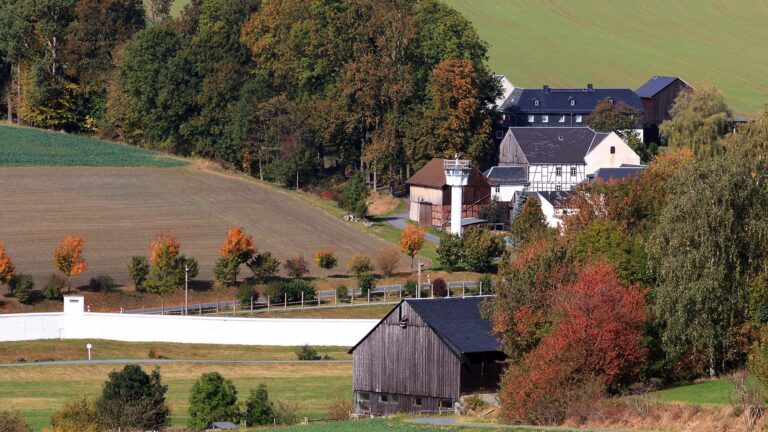Cold War Sites & memorials in Germany
Perhaps the most well known and iconic Cold War historic site in Germany is the Berlin Wall. Despite official attempts to remove it, there are a number of places where original features of the Wall still survive. As do other parts of the Iron Curtain, such as the Marienborn border crossing on Autobahn 2. There is more to the Cold War than the physical barrier that divided East and West. Many towns and cities had Stasi offices and prisons, some of which are now museums and/or documentation centres. The Marienthal Bunker, intended to house the West Government in case of Soviet attack, is open to the public.

Cold War Sites in Berlin
More than 30 years on, despite an initial desire to remove all traces of the Wall, there are portions of the wall still standing in the original position. The highly controlled communist state relied on an oppressive and brutal security apparatus, of detention centres and prisons. Some of these have been transformed into documentation centres with moving exhibitions about the atrocities of the Cold War era in Berlin. For those interested in this period of European history, there is still a lot to experience in the German capital. From fragments of the Wall to museums about life in East Berlin. From Stasi Prisons to attractions using state-of-the-art technology to tell the story of a divided city.
Cold War Sites & Memorials in Germany
German Government Bunker
Near the small town of Ahrweiler, the Cold War bunker served as a secure location for the German government to operate from in the event of a nuclear attack. Built underground between 1960 and 1972, it is an extraordinary feat of engineering as the bunker was designed to withstand a direct hit from a nuclear strike. It could accommodate up to 4,000 people for several weeks. Today visitors can take guided tours of the facility and see the living quarters, communication centres, and medical facility.

Hanstein Castle, Bornhagen
Considered one of the most beautiful ruined castles in central Germany, Hanstein Castle certainly makes for a picturesque silhouette among timber-framed buildings. First mention of the castle dates to 1070, noting its destruction. Given its strategic value, the castle was rebuilt and damaged several times in its history. As it was close to the border between East and West Germany, the CDR took control of the ruins and the towers used as a border watch tower. No visitors were allowed until after Reunification. A popular medieval festival takes place at the castle every year on the first weekend of August.

Marienborn / Helmstedt Border Crossing
The border crossing at Helmstedt/Marienborn was set up on 1 July 1945 on the Hanover-Berlin autobahn, It was the sole access point to the divided city of Berlin. In May 1952 the GDR took control of the checkpoint and set up a deadly regime, using barbed wire, signal fences and mines. Bteween 1985 and 1989 around 35.6 million travellers were processed at the border crossing. Over 1,000 people worked here, until the facility closed on 30 June 1990. Today visitors can take a guided tour or walk freely throughout this distinctive commemorative site of a divided Germany.

Memorial and Museum Sachsenhausen
From 1936 to April 1945 Sachsenhausen was used by the Nazi regime as a concentration camp. It mainly held political prisoners, and a number of high profile individuals were interned here. Including the wife and children of the Crown Prince of Bavaria. The camp was equipped with a medical experimentation centre and a gas chamber, the remains of which can still be seen. After the war this area was in the Soviet Zone, and the camp was used by them to house enemies of the Soviet state from August 1945 to the spring of 1950 – Special Camp Nr. 7.

Mödlareuth Memorial & Museum
In the early 1950s the rural medieval village of Mödlareuth became known as ‘Little Berlin’. Like the city, the village was physically divided in 1952, at first by a wooden fence, then later by the same concrete barrier system that divided the two German states. Mödlareuth lies on the border between Thuringia (then in the Soviet Occupation Zone) and Bavaria (American Occupation Zone), hence the partition of the village into East and West Germany, where social and familial ties were forcibly broken. Following the fall of the Berlin Wall, residents bulldozed most of the dividing wall, but a section was retained and is now a memorial and a museum recounts this period of the village’s history.

Moritzplatz Memorial Magdeburg
Built in the first half of the 1870s, the Prussian district court and city prison on the north side of Moritzplatz continued to serve as a place of detention during WWII. Immediately after the war, the Soviets took control before East German law enforcement agencies, who continued to used the building as a detention centre until 1989. Today the historic court and prison stands as a memorial not only to the 10,000 plus victims of political persecution between 1945 and 1989, but also the victims held here by the Nazis. The memorial houses a permanent exhibition, “In the name of the people? About the judiciary in the SED state”.

Runde Ecke Memorial Museum
In what was for 40 years the Stasi’s headquarters of the Leipzig District is now a museum that tells the history of the secret service in Leipzig during the period of the GDR. The central, permanent exhibition is ‘Stasi – Power and Banality. Curated by the Citizens Committee of Leipzig, which was formed during the peaceful revolution in 1989. The demonstration that on 9 October 1989 brought down East Germany and the fall of the Iron Curtain. The custodians have tried to preserve the decor and contents of the Stasi offices as it was at the end of 1989, from linoleum floors and radiators, from surveillance cameras to shredding machines.

Waldsiedlung Wandlitz
In a forest setting in Bernau bei Berlin, but closer to Wandlitz (hence the name) is the former housing estate used by members and candidates of the East German SED Politburo from 1960 to 1989. The likes of Honecker, Ulbricht, Mielke and Krenz lived here. Today the houses look basic, but for the time and in Eat Germany these were luxurious residences in a high security complex that included an event hall, a shop (that had luxury items from West Berlin) and a nuclear bunker. After reunification the settlement became a rehabilitation centre and a residence for senior citizens. It is a popular day trip from Berlin for hikers.









